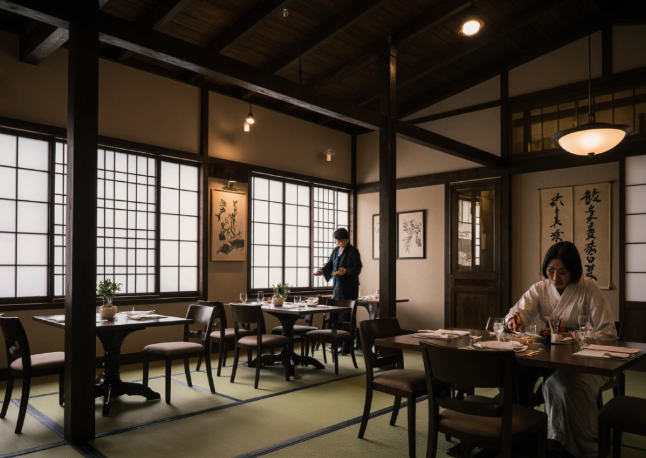Pontocho Kaiseki represents Japan’s highest form of culinary artistry—a meticulously choreographed dining experience where each course tells a story through seasonal ingredients, precise technique, and centuries-old traditions. In Pontocho, Kyoto’s atmospheric riverside dining district, this culinary art form reaches its most authentic expression, offering travelers a window into Japanese culture that goes far beyond simply eating a meal.
More about Pontocho:
- Pontocho Park Guided Tours
- The Complete Guide to Pontocho: Kyoto’s Most Atmospheric Alley
- Pontocho Restaurants: Complete Dining Guide
What Makes Kaiseki Different from Regular Japanese Dining?
Kaiseki transforms dinner into a cultural ceremony where presentation, timing, and seasonal awareness matter as much as taste. Unlike ordering à la carte at typical establishments, you receive a predetermined sequence of 7-12 small courses, each served in handcrafted ceramics chosen specifically for that dish and season. The chef decides everything—you’re essentially trusting them to guide you through Japan’s culinary philosophy for the next two hours.
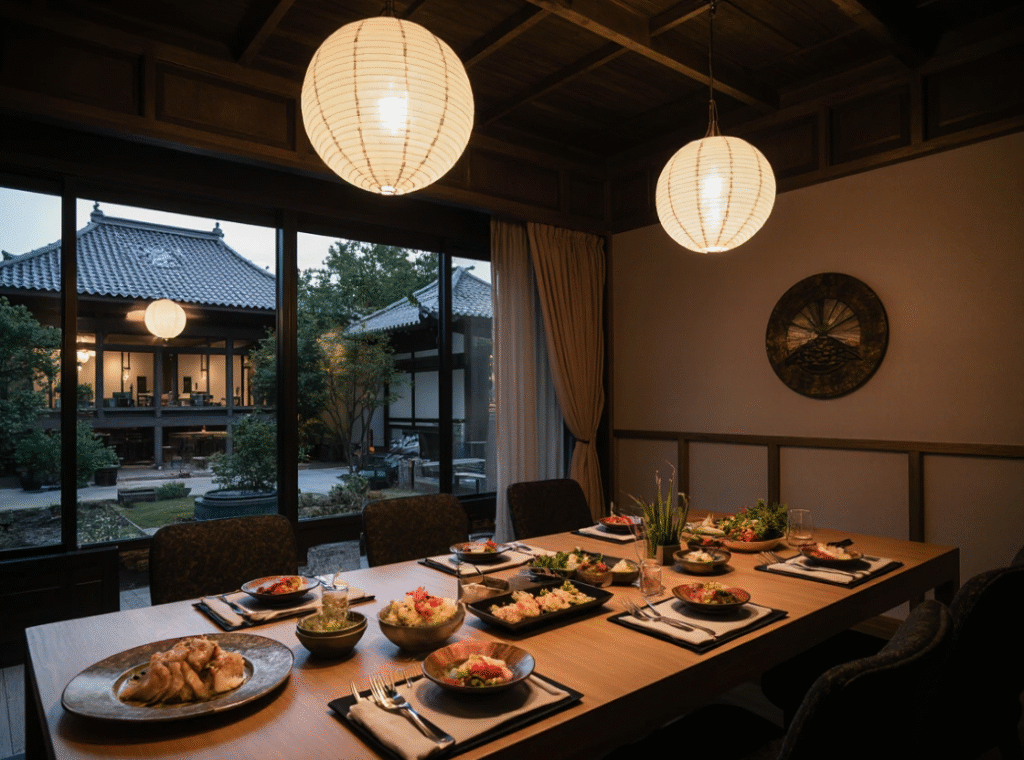
Traditional Kaiseki Dining in Pontocho – Authentic Kyoto Dining Experience
The format originated in the 16th century as a light meal served during tea ceremonies. Buddhist monks needed something to “warm the stomach” (the literal meaning of kaiseki) without breaking their principles of simplicity and seasonality. Over centuries, this evolved into the elaborate multi-course experience we know today, though the core philosophy remains: respect the ingredient’s natural flavor, honor the season, and create harmony between food, vessel, and setting.
What sets this dining style apart from Western tasting menus is the concept of omotenashi—anticipatory hospitality. Your server won’t just bring food; they’ll explain each ingredient’s origin, why it was chosen for this particular month, and sometimes even the pottery’s history. In Pontocho specifically, many venues overlook the Kamo River, adding visual poetry to the sensory experience.
The Anatomy of a Traditional Dinner Pontocho: What to Expect
A traditional dinner Pontocho follows a specific structure, though individual establishments add their signature touches:
- Sakizuke (appetizer): A single bite that sets the evening’s tone
- Hassun: The seasonal cornerstone—usually includes one item from the mountains and one from the sea
- Mukozuke: Sashimi course featuring the day’s best catch
- Takiawase: Simmered vegetables that showcase knife skills and timing
- Futamono: Lidded soup bowl, often with delicate broths and surprising ingredients
- Yakimono: Grilled fish or seasonal protein
- Su-zakana: A palate cleanser, typically something vinegared
- Hiyashi-bachi: A chilled dish for warm months, or replaced by something warming in winter
- Shokuji: Rice, miso soup, and pickles
- Mizumono: Seasonal dessert, usually fruit-based
The courses arrive with careful pacing—roughly 10-15 minutes between each. This isn’t about filling up; portion sizes are modest. You’re eating just enough of each dish to appreciate its essence before moving to the next flavor profile. Think of it like reading chapters of a book rather than scanning headlines.
The progression follows a deliberate arc. Early courses are lighter and more delicate—raw fish, clear broths, subtle vegetables. Mid-meal courses introduce richer, grilled elements that build intensity. The finale brings you back to simplicity with rice and pickles, resetting your
“First-timers often worry about chopstick etiquette and miss the bigger picture. The real rule is simple: eat each course completely before the next arrives. The chef has orchestrated specific flavor progressions, and jumping ahead disrupts the entire narrative they’ve built.”
How Pontocho Became the Heart of Kyoto Kaiseki Dining
Twenty years ago, Pontocho was primarily known to locals as a geisha entertainment district—a narrow alley where exclusive ochaya (tea houses) catered to established clientele with deep pockets and proper introductions. Fine dining existed here, but remained largely inaccessible to outsiders, protected by layers of tradition and insider networks.
Two factors transformed Pontocho into today’s destination for Kyoto Kaiseki dining seekers. First, Kyoto’s designation as a UNESCO World Heritage site brought unprecedented international attention. Tourism boards needed to showcase Japanese food culture beyond sushi, and kaiseki became the ambassador. Second, the economic shifts of the early 2000s forced many traditional establishments to reconsider their closed-door policies. Younger chefs, trained in classical techniques but facing inheritance challenges, began opening venues that welcomed first-time visitors—no introduction required.
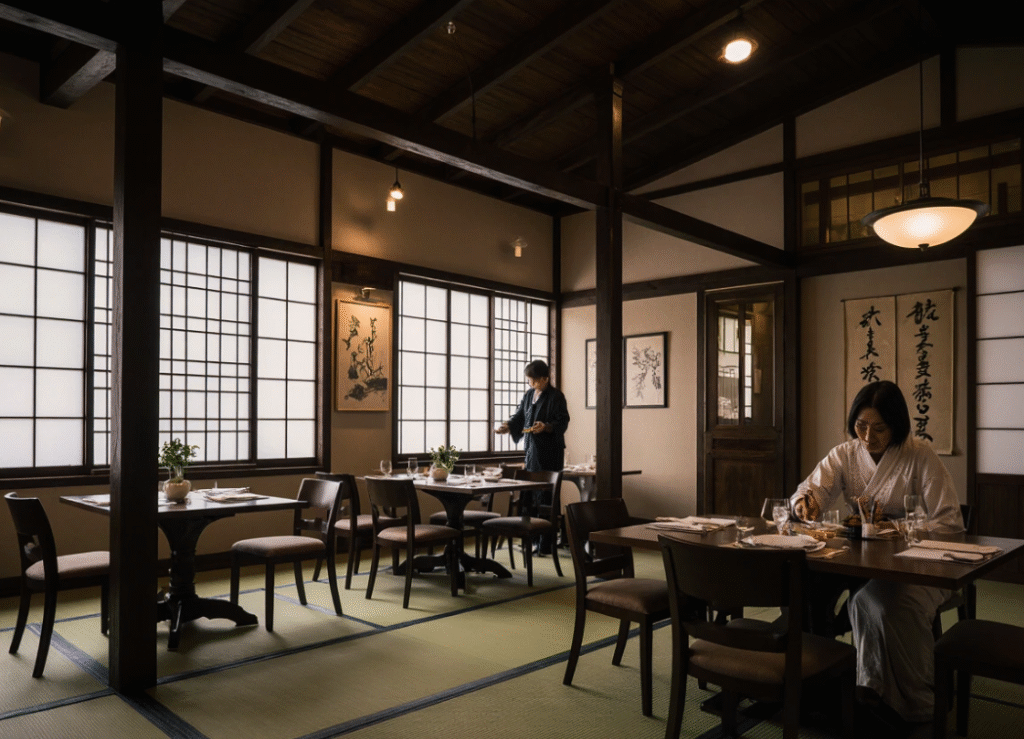
Traditional Kaiseki Restaurant Interior in Pontocho, Kyoto with Tatami Mats
The alley could have evolved into a theme-park version of itself, filled with tourist traps serving abbreviated “kaiseki-style” meals. Instead, Pontocho’s geographic constraints (it’s literally one narrow street, roughly 500 meters long) created natural selection. Only serious operators could afford the limited real estate. The result: a concentration of legitimate establishments that maintain exacting standards while accepting reservation-savvy travelers.
This accessibility shift means you can now experience what was once reserved for business executives entertaining clients or families celebrating major milestones. But traditional Kaiseki Pontocho venues still operate on different rules than typical dining—rules worth understanding before you book.
Choosing Your Traditional Kaiseki Pontocho Experience
| Factor | Michelin-Starred (¥25,000-50,000) | Mid-Range Traditional (¥12,000-20,000) | Modern Interpretation (¥8,000-15,000) |
| Booking Window | 2-3 months advance | 3-4 weeks advance | 1 week usually sufficient |
| Atmosphere | Formal, hushed, camera-discouraged | Traditional but relaxed | Contemporary, photo-friendly |
| Course Count | 10-13 courses | 8-10 courses | 7-9 courses |
| Dietary Accommodations | Limited flexibility | Moderate (if notified early) | More adaptable |
| Best For | Once-in-lifetime experience seekers | Serious food enthusiasts | First-time kaiseki diners |
The pricing difference isn’t just about prestige. Top-tier establishments source from specific farms and fishermen they’ve worked with for decades, sometimes paying triple market rate for ingredients most diners wouldn’t distinguish from regular premium quality. They’re also commissioning artisan ceramics that cost hundreds of dollars per piece. Mid-range spots use excellent ingredients but without the extreme sourcing relationships. Modern interpretations may incorporate non-traditional elements—a foam here, a Western technique there—which purists debate but newcomers often find more approachable.
Critical booking mistake: Reserving a Michelin-starred multi-course meal on your first night in Kyoto. Your jet-lagged palate won’t appreciate the subtleties you’re paying premium prices to experience. Worse, the meal’s pacing assumes you’re alert enough to engage with each course’s story. Book it for day three or four minimum, after your sleep schedule adjusts and you’ve eaten enough Japanese food to recognize when something transcendent appears on your plate.
The Real Costs of Pontocho Kaiseki Beyond the Menu Price
That ¥15,000 price you see listed? It’s the starting point, not the total. Here’s what actually goes on your bill:
- Base menu: ¥15,000
- Sake pairing (recommended, often essential): ¥5,000-8,000
- Service charge (typically 10%): ¥1,500-2,300
- Seat charge (some establishments): ¥500-1,000
- Upgraded courses (if you select premium options): ¥3,000-10,000
Real total per person: ¥25,000-35,000 ($170-240 at current exchange rates)
The sake pairing isn’t optional in practical terms. Chefs design courses with specific beverages in mind. Drinking water or green tea throughout means missing half the experience—like watching a color movie in black and white. The sommelier selects regional sake that complements each course’s dominant flavors. Skip it and you’re essentially paying for a performance while wearing earplugs.
Compare this to a high-end tasting menu in New York or San Francisco ($250-400 per person), and Kyoto Kaiseki dining delivers comparable craftsmanship at 30-40% less cost. The value proposition isn’t about cheap eating—it’s about accessing world-class culinary artistry at prices that don’t require a second mortgage.
Case study: An American couple booked a ¥18,000 per person dinner, thinking they’d spend roughly $250 total for two. They skipped sake pairing to save money and didn’t anticipate the 10% service charge. Final bill: ¥39,600 ($270), which felt like a budget failure. Had they budgeted for ¥30,000 per person from the start ($410 total), they could have enjoyed the full sake pairing experience for $450 total—only $40 more but dramatically better value for money spent.
When Not to Choose Traditional Kaiseki Pontocho
This dining format isn’t for everyone, and pretending otherwise wastes money and creates disappointment. Skip Pontocho Kaiseki entirely if you:
- Prefer controlling your meal: You can’t substitute courses, request extra portions, or eat courses out of order. The chef’s vision is absolute. If you’re the type who modifies orders or prefers buffets where you choose quantities, the rigid structure will frustrate you rather than delight you.
- Have significant dietary restrictions: Vegetarian options exist but drastically limit the chef’s palette—you miss seafood courses that often represent the meal’s pinnacle. According to the Japan National Tourism Organization, allergies to soy, fish, or shellfish eliminate fundamental building blocks of traditional Japanese haute cuisine. Venues may accommodate with advance notice, but you’re essentially asking them to compose a symphony without strings or brass.
- Want to feel full: This dining style prioritizes balance and subtlety over satiety. You’ll eat a satisfying amount, but not the stomach-stretching portions common in Western fine dining. If your satisfaction meter requires feeling stuffed, this isn’t your format.
- Travel with young children: The typical 2-2.5 hour duration, hushed atmosphere, and expectation of focused attention make multi-course meals challenging for kids under 12. Many Pontocho establishments explicitly don’t accept children, not from snobbery but from protecting other diners’ experiences. One wiggling, bored child in a 10-seat dining room affects everyone’s $200 meal.
- Are extremely jet-lagged or exhausted: You need mental energy to appreciate the experience. When you’re fighting to keep your eyes open, even the most spectacular meal becomes a blur of pretty plates you’ll barely remember.
The real cost of booking when it’s wrong for you: $200+ per person plus the opportunity cost of an evening you could have spent at an izakaya, ramen shop, or casual tempura counter that would have genuinely delighted you. That’s $400 for a couple, plus the emotional cost of feeling like you “didn’t get it” when the issue was simply a format mismatch.
Three Common Mistakes That Diminish Your Kyoto Kaiseki Dining Experience
Mistake #1: Arriving with Strong Perfume or Cologne
- Why travelers do this: They’re dressing up for an expensive dinner, applying the same grooming approach they’d use for fine dining back home.
- The damage mechanism: Multi-course meals feature delicate aromatics—yuzu zest, kinome leaves, subtle dashi. Your server leans in to explain each dish, and strong perfume overwhelms these carefully calibrated scents. Worse, in intimate dining rooms with 8-10 seats, your fragrance affects neighboring diners who can’t taste their food properly when their olfactory sense is hijacked.
- Price of the mistake: You experience perhaps 60% of each dish’s intended impact. Your neighbors may experience even less. For a ¥25,000 meal, you’ve essentially paid for a ¥15,000 experience. You’re nose-blind to your own cologne, so you don’t even realize what you’re missing.
Mistake #2: Filling Up on the Early Rice Course (When Offered)
- Why travelers do this: The rice arrives beautifully presented, often in a traditional wooden tub. It feels rude to take only a small portion, and Westerners are conditioned to view rice as a main dish to fill up on.
- The damage mechanism: Traditional Japanese meals save rice for the final third as a transition toward closure. Some venues serve a small rice portion mid-meal as a palate reset. Filling your bowl means you’ll struggle with the remaining courses, particularly if there’s a substantial grilled fish or meat course still coming. You’ll also likely skip seconds on rice during the proper rice course, which signals to your server that something was wrong.
- Price of the mistake: You’re too full to properly enjoy 2-3 courses worth ¥6,000-8,000 of your meal’s value. Plus, you might feel uncomfortably stuffed for the next two hours—not ideal when you’re trying to walk off dinner along the Kamo River afterward.
Mistake #3: Photographing Every Course While Food Gets Cold
- Why travelers do this: Instagram. The presentation is stunning. You want proof you ate at this level. Friends expect photos.
- The damage mechanism: Many courses are temperature-specific. That delicate chawanmushi (steamed egg custard) is perfect at exactly 65°C. Two minutes of photography drops it to 50°C, where the texture changes and flavors mute. Tempura courses deteriorate even faster—the coating loses its signature crackle within 90 seconds. While you’re editing your third angle, the chef’s precise timing work is evaporating.
- Price of the mistake: You’re eating a degraded version of dishes that required hours of preparation and split-second execution. Multiple courses affected means you’ve downgraded perhaps ¥5,000 worth of your meal. The solution: Take one quick photo when the course arrives, eat immediately, then photograph the empty vessel if you want the pottery details.
“We never tell guests not to photograph—that would be unwelcoming. But I watch travelers spend three minutes staging their phone while their dish crosses the temperature point of no return. A professional food photographer takes their shot in 15 seconds and puts the camera down. That’s what we hope guests would emulate.”
How to Book Authentic Pontocho Kaiseki Venues
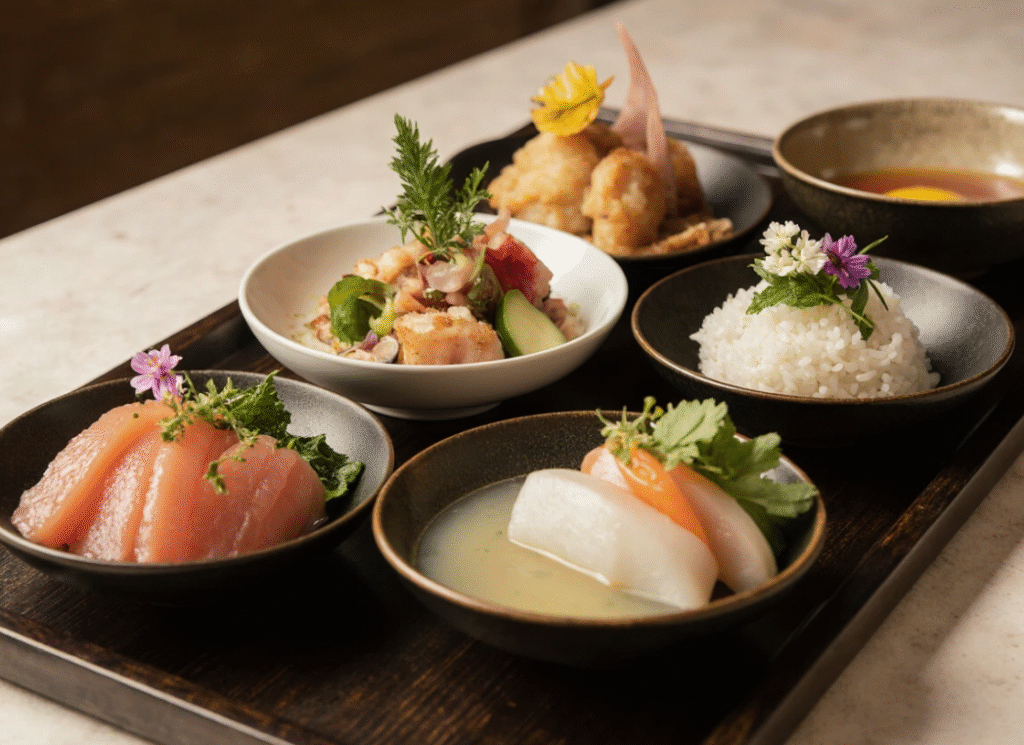
Close-up of Kaiseki Dishes – Traditional Kyoto Kaiseki Cuisine
Most establishments don’t use OpenTable or typical English-language booking platforms. You’ll need to:
- Email directly (many now have English inquiry addresses listed on their websites)
- Use your hotel concierge (they have relationships and can navigate language barriers)
- Book through reservation services like Pocket Concierge, TableCheck, or byFood that specialize in Japanese dining
When booking, provide this information in your first message to avoid back-and-forth delays:
- Preferred date with 2-3 backup options
- Number of diners
- Any allergies or dietary restrictions (be comprehensive—this isn’t the time for surprises)
- Seating preference if applicable (counter seats offer best interaction with chefs, private rooms better for conversation)
- Whether you want sake pairing
Book 4-6 weeks ahead for standard spots, 8-12 weeks for top-tier establishments. Summer and autumn (especially October-November for fall foliage season) require even more lead time. Cherry blossom season (late March-early April) is similarly competitive.
Most venues require credit card guarantee and charge 100% cancellation fees for no-shows or same-day cancellations. This isn’t hostility—ingredients are sourced specifically for confirmed reservations. When you don’t appear, that day’s Hokkaido crab and seasonal vegetables can’t be repurposed for walk-in diners because there are no walk-ins.
What Happens During Your Pontocho Kaiseki Evening
You arrive at your reserved time—punctuality matters in Japanese dining culture. Five minutes early is ideal; late arrivals disrupt the kitchen’s carefully orchestrated timing for all diners. One party running 20 minutes late can throw off the entire evening’s service rhythm.
After removing shoes (most traditional venues require this), you’re seated. Counter seating puts you directly across from the chef, who often explains courses personally. Table seating is quieter, better for conversation with your group. Riverside seats overlooking the Kamo River cost premium but add atmosphere worth the extra ¥2,000-3,000 per person.
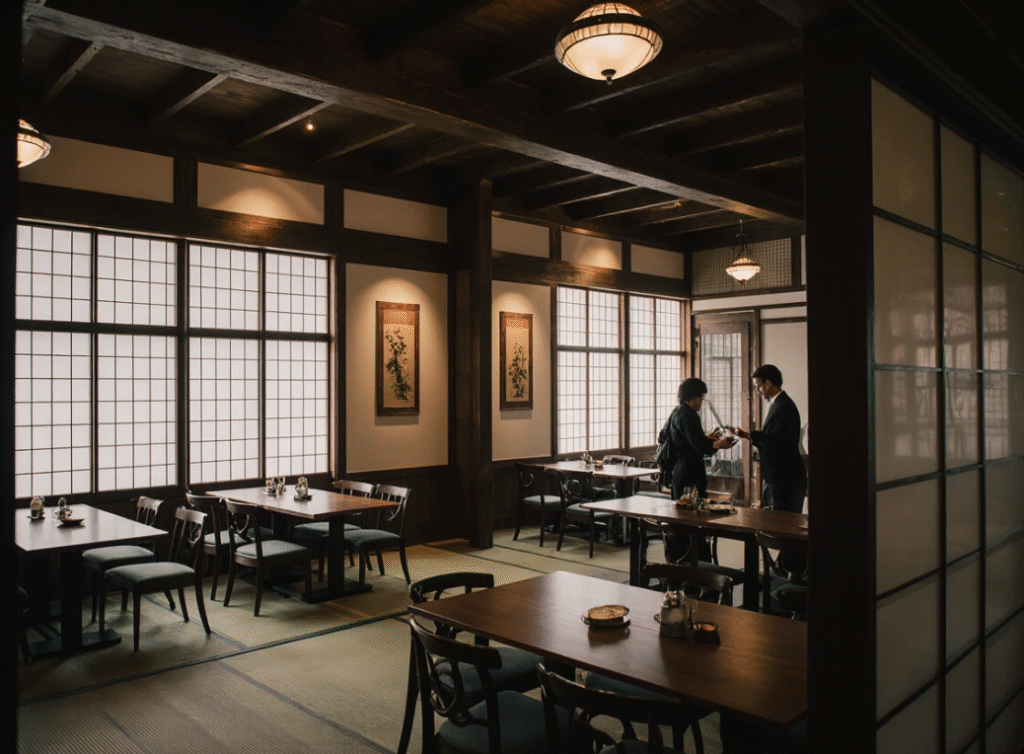
Courses arrive individually with 10-15 minute intervals. Your server or chef explains each dish—ingredients, origin, preparation method, and often the pottery’s provenance. Feel free to ask questions; engagement is welcomed. What’s not welcomed: sending food back, requesting modifications, or asking for courses in different order.
Sake pairing means a different small pour arrives with each course. You don’t need to finish every glass—the point is tasting how the pairing changes your perception of the food. Switching between sake and water is expected and keeps your palate fresh. The sommelier adjusts pour sizes based on your pace, so don’t feel pressured to match anyone else’s drinking speed.
The meal concludes with rice, soup, pickles, and a light dessert—usually seasonal fruit presented with stunning simplicity. This signals the evening’s end. You’ll likely feel pleasantly satisfied but not stuffed, energized by the experience rather than food-coma sluggish.
Total duration: 2 to 2.5 hours. Budget your evening accordingly—don’t schedule anything immediately after. Many travelers underestimate this and book a 9pm activity after a 6:30pm reservation, only to realize they’re still at the table at 8:45pm.
Beyond Pontocho: Alternative Kaiseki Restaurants Kyoto Offers
Pontocho offers atmosphere and tradition, but it’s not Kyoto’s only option for authentic multi-course dining. Consider exploring:
- Gion district: More formal, even more traditional, with some venues requiring Japanese-speaking intermediaries for initial bookings. Better for travelers who’ve already experienced the format and want to go deeper into the cultural aspects. Prices run 20-30% higher than comparable Pontocho spots.
- Kiyamachi: Pontocho’s parallel street, one block east. Similar riverside setting, slightly lower prices (typically ¥2,000-3,000 less per person), fewer English-speaking staff but equally skilled chefs. Less atmospheric but more accessible for last-minute bookings.
- Arashiyama: Western Kyoto, near bamboo groves. Dining here often incorporates mountain vegetables and river fish, different from Pontocho’s ocean-focused menus. The tradeoff: you gain unique ingredients but lose the historic geisha district atmosphere.
- Hotel dining rooms: Major hotels like the Ritz-Carlton Kyoto offer accessible options that sacrifice some authenticity for convenience and English support. It’s the training-wheels version—still good food, less cultural immersion, but you can book the same-week and ask questions without language barriers.
The tradeoff: Pontocho Kaiseki gives you the full atmospheric package—narrow lanes, lantern-lit evenings, river views, traditional architecture, concentrated culinary quality. Venturing elsewhere might save ¥3,000-5,000 per person but reduces the “this is exactly why I came to Kyoto” factor that makes the meal a story you’ll tell for years.
Making Kaiseki Part of Your Kyoto Story
This dining experience isn’t just dinner—it’s a compressed introduction to Japanese aesthetic principles, seasonal awareness, and the idea that how you experience food matters as much as what you’re eating. You’re not paying primarily for calories or even flavors, though both are exceptional. You’re paying for two hours where every detail receives obsessive attention: the ceramic choice, the garnish placement, the progression from light to rich to light again.
Whether this appeals depends entirely on what you value in travel. If checking the box matters less than the actual experience, book mid-range, arrive mentally present, and resist the urge to treat it like a normal meal. If you’re genuinely excited about understanding Japanese culinary philosophy through direct experience, Kyoto Kaiseki dining delivers that education more effectively than a week of reading could.
Your alternative is spending the same ¥25,000 on five excellent casual meals across Kyoto—ramen, tempura, yakitori, okonomiyaki, and sushi at neighborhood spots. You’d eat more food, probably have more fun, and create more varied memories. The choice means sacrificing quantity and casual enjoyment for depth and cultural immersion in a single evening.
Neither choice is wrong. But understanding what you’re actually choosing—and what you’re giving up—makes the difference between a meal that becomes a highlight story you repeat for years and an expensive dinner you remember mainly for its price tag.
